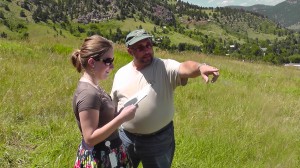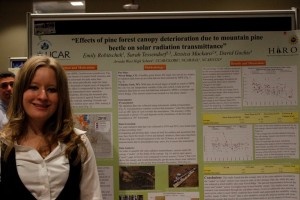This week we have a guest blogger. Emily Robitschek is currently a senior at Arvada West High School near Denver, Colorado. Emily worked in the GLOBE Program Office (GPO) in the summer of 2011 as part of a high school research internship program (HIRO) at the University Corporation for Atmospheric Research (UCAR). Emily is currently applying to college and plans to double major in biological sciences and foreign language.
I’d never really thought of doing a scientific project before, in part because my school doesn’t put a big emphasis on science projects and science fairs. However, after I found out about the UCAR HIRO internship (now SPARK Pre-College Internship) by accident, I really wanted to apply to the program so I could learn about atmospheric science. The HIRO internship gave me opportunities to participate in actual research and work with established scientists and was a very fulfilling experience. As a young, inexperienced yet enthusiastic scientist, it helped me get a sense of what working in a science field would actually be like, which is how I first landed at the GLOBE office. I remember being very intimidated the first day by meeting all these scientists and getting my first office all to myself in the GLOBE headquarters. At the time I was thinking, “Wow. All these people actually do this for a living. I bet they have all probably published papers or aided in research and improved society in some way.” I was slightly scared, but the GLOBE office was a welcoming environment and with the help of my mentors and the staff there I quickly settled in, becoming close with many of my co-workers. (They’re all so nice and wonderful!)
Dr. Sarah Tessendorf and Jessica Mackaro let me pick my topic for research with the suggestion that it be related to Colorado climate. That’s how I first started doing research on pine beetles and their impact on climate. Specifically, I looked at how trees dying because of mountain pine beetle could change the amount of sunlight that reaches the ground, and the possible implications of that on hydrological processes. Although at first the topic seemed rather inconsequential, I started to become more and more interested in it as I learned about the impacts of the pine beetle epidemic. Armed with raw data from Dr. Dave Gochis, I began the laborious process of learning what science is like in the “real world.” These processes were both more tedious (with data screening and the inevitable multitude of sources of error) and more enjoyable (discussing results and exploring possibilities with scientists who seemed suspiciously like normal people) than I expected them to be. I learned that while television shows like NOVA and CSI might portray research as being a very speedy process, it’s actually quite slow. But from my internship I learned the valuable skill of thoroughness, and tried my best to carefully consider every possibility within my project, from data screening to analysis and conclusions.
Presenting a poster of my results at the UCAR symposium and the 2012 American Meteorological Society Conference in New Orleans was nerve-wracking. However, as a student scientist these experiences were some of the most enjoyable things I did in connection with UCAR and GLOBE, and well worth any nervousness I experienced. I learned a lot about science and scientific instruments at the conference, even as my journey between conference booths devolved into a search for candy and pens. I talked to a guy at one booth about pyranometers, which are the instruments I used in my data analysis. We talked about how they work, what the advantages of certain models are, and how error can be minimized for over half an hour, and then he gave me a book to read more about it.
Looking back I am really happy that I met the people I did, and got the opportunity to research the climate effects of pine beetles. I can’t believe they even let me have my own office—I was 17 and I had my own office, a computer, and a badge that unlocked doors. That’s basically what this research internship did for me—unlock doors, not just in a physical sense, but in an intellectual sense as well; I grew even more passionate about science and confident that I could actually do research. Pretty cool.
–Emily Robitschek



Emily, thank you so much for sharing! Emily was one of the guest speakers at a webinar for Iowa GLOBE teachers this fall to and she did a wonderful job communicating her project. We are using the scientific journal article that Emily, Sarah and Jessica assigned our teachers as an example of a complex text for the Lit. SS, Science and Text Reading Standards. Thanks Emily!
Dear Emily,
I think it is wunderfull, that young people linke you get the chance to make such a interensting experiance. It would be great if more joung people could benefit from a good organisation like globe and learn about sience or other important thinks.
I wish you all the best for your future as a sicentist and thank you for sharing your thoughts.
It would be great if more joung people could benefit from a good organisation like globe and learn about sience or other important thinks
Yes !
It is just awesome that young people like Emily get the change to work in an organisation like this one. A great project which should be startet as well in other organisations. Keep up the good work.